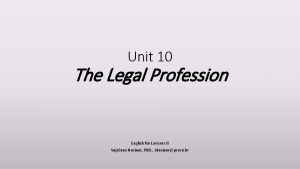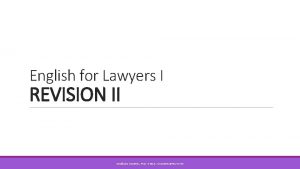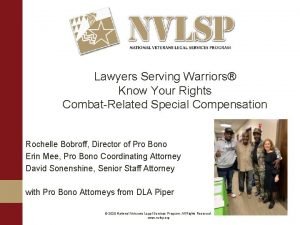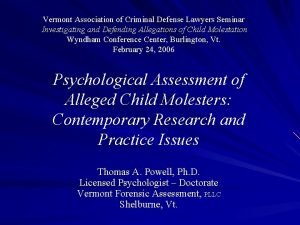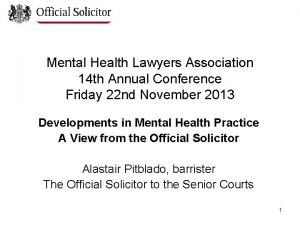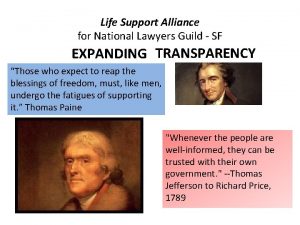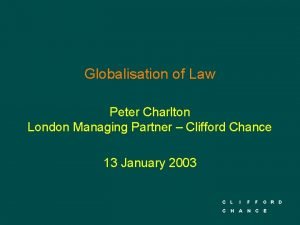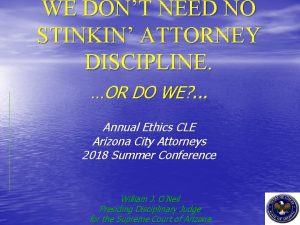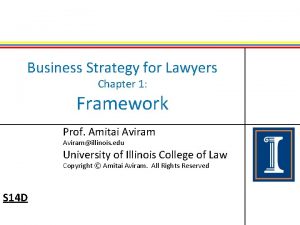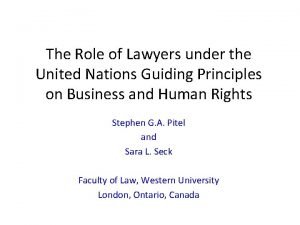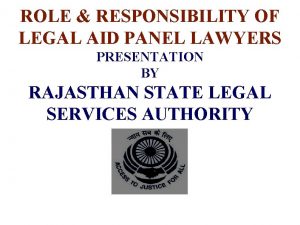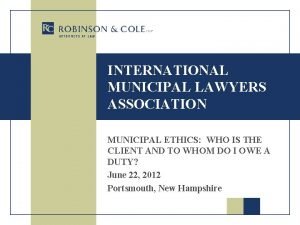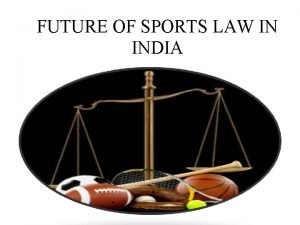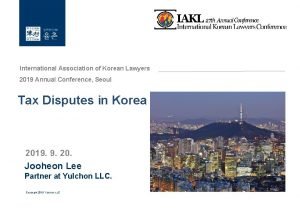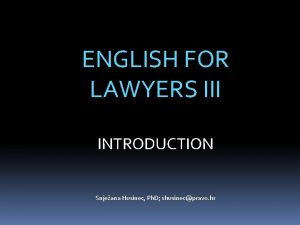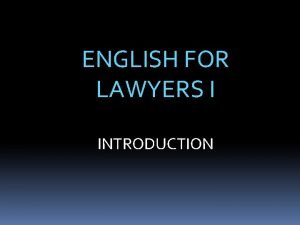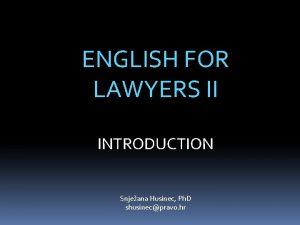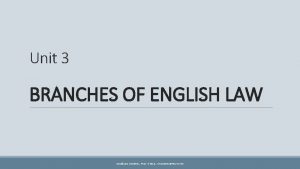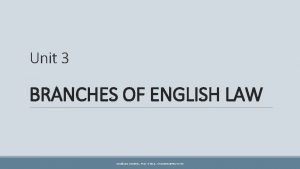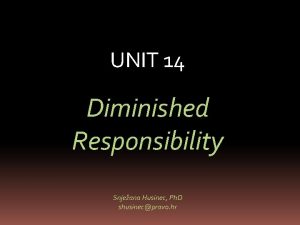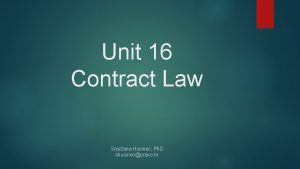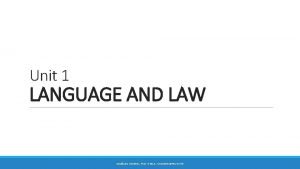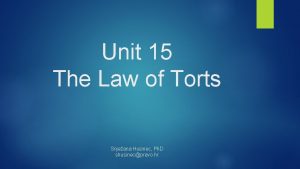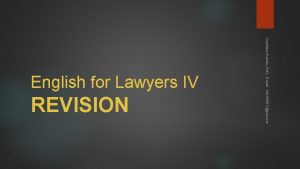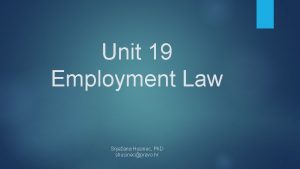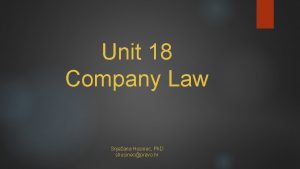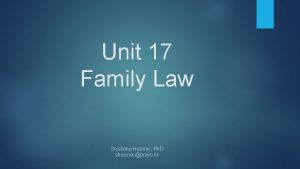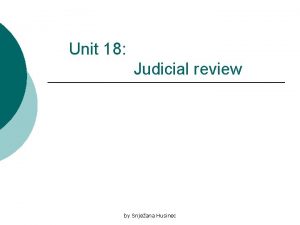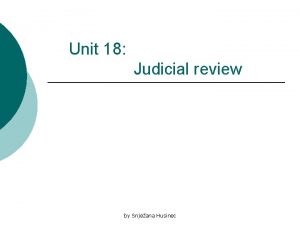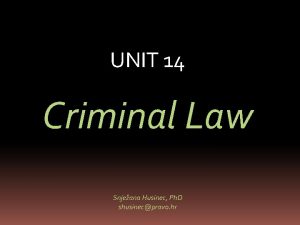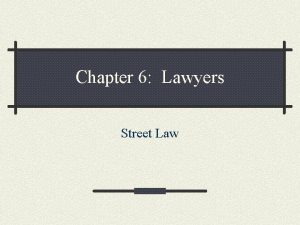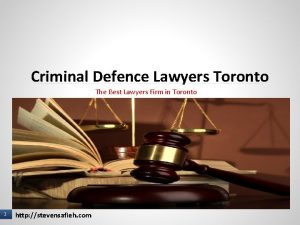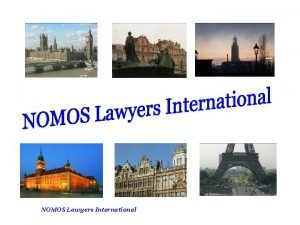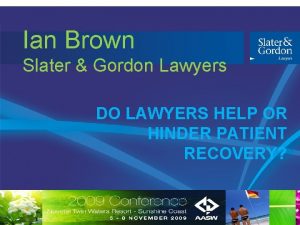ENGLISH FOR LAWYERS II INTRODUCTION Snjeana Husinec Ph
























- Slides: 24

ENGLISH FOR LAWYERS II INTRODUCTION Snježana Husinec, Ph. D shusinec@pravo. hr

LECTURER Snježana Husinec, Ph. D Office hours: Monday, 14. 00 -15. 00. , Gundulićeva 10, Office 2 A Contact: shusinec@pravo. hr

English for Lawyers II Obligatory literature 1. Coursebook Sočanac, Matijašević, Javornik Čubrić, Husinec, Horvatić Bilić: English for the Legal Profession. Zagreb: Narodne novine, 2017. 2. Teacher’s presentations (www. pravo. hr – Katedra za strane jezike, predmeti, Engleski jezik pravne struke I, Nastavni materijali, Snježana Husinec

Additional reading RECOMMENDED GRAMMAR BOOK M. Hewings, Advanced grammar in Use, 12 th printing, Cambridge University Press, 2004

Recommended dictionaries GENERAL ENGLISH Oxford Advanced Learner’s Dictionary LEGAL ENGLISH A) Monolingual Black’s Law Dictionary P. H. Collin, Dictionary of Law, 03 rd edition, Peter Collin Publishing, London, 2002 Online dictionaries: www. legal-dictionary. org legal-dictionary. thefreedictionary. com B) Bilingual M. Gačić, English-Croatian Dictionary of Law, Naklada Ljevak, Zagreb, 2004 V. Ivir, Croatian-English Dictionary of Business and Government, Školska knjiga, Zagreb, 1998

Course syllabus MODULE II: Anglo-American Legal Systems Unit 7: The Sources of English Law Unit 8: The Hierarchy of English Courts and the Doctrine of Precedent Unit 9: Parliament and Legislation Unit 10: The Legal Profession Unit 11: American Federalism Unit 12: The Executive Branch in the USA Unit 13: The Supreme Court of the USA

Participation and Attendance PARTICIPATION in the lecture – OBLIGATORY ! REGULAR ATTENDANCE – no more than 3 absences REGULAR ATTENDANCE REWARDED by: A) the possibility to take the mid-term and endterm test B) bonus task and bonus points in the midterm and end-term test

Requirements for the examination Tested knowledge: A) vocabulary B) content (presented in the coursebook and during the lecture) 1. Written qualifying exam (focus on terminology and relevant grammar) OR MID-TERM TEST – April 24 (Gr. B 1), April 25 (Gr. C 2) + END-TERM TEST – June 12 (Gr. B 1), June 13 (Gr. C 2) (for those with regular attendance) 2. Oral exam (speaking about the topics covered by the curriculum – using relevant legal terms)

Additional information STUDENT MENTORS - students with excellent command of English assisting their weaker colleagues TEMPUS STUDY ROOM Trg Republike Hrvatske (in the basement) Monday – Friday = 10 a. m. – 2 p. m. - a variety of useful resources (dictionaries, legal books on different topics) - free Internet access

OPTIONAL ASSIGNMENT - recommended - 15 minute presentations on topics related to the curriculum - 1 or 2 students prepare an oral report and present it in the class Before giving the presentation students must: a) discuss the chosen topic with the lecturer, who then (if acceptable) approves it b) consult at least 3 RELIABLE sources and prepare a draft of their presentation c) prepare a handout (to be distributed to colleagues before the presentation) a) show the PP presentation, the notes and the handout to the lecturer REWARD for successful presentation – exemption from taking the oral exam

What makes a good presentation? - good preparation – be “an expert” in the area that you present - usage of reliable sources – don’t copy the whole paragraphs of text from your sources – retell them in your own words - relevant information – separate the important facts from less relevant ones - clear structure – introduction, body, conclusion - speaking freely to the audience – practice the whole presentation aloud a few times

How to become a good presenter? 3 basic rules: 1) KISS – “keep it short and simple” principle 1) TTT – introduction- Tell them what you are going to tell them - body – Tell them what you want to tell them. - conclusion – Tell them what you have just told them. 1) audience oriented – eye-contact !!! - voice - speak up, use pauses, - face - enthusiasm

Presentations - Example topics The Supreme Court of the UK The Legal Profession in the USA The US Constitution and the Bill of Rights The Bill of Rights – a Case Analysis The English Bill of Rights (1689) The Declaration of Independence The Watergate Scandal The Clinton Impeachment of Justice Samuel Chase The Australian/Canadian Legal System …

REVISION Of KEY TERMS AND CONCEPTS

BRANCHES OF LAW CIVIL LAW vs. CRIMINAL LAW CIVIL LAW = regulates ______________________ The _______ sues (brings an action) against the _______. The judge passes ______ LIABLE or ______ Remedy: __________ CRIMINAL LAW = is concerned with _________________ The ______ prosecutes (brings a case against) the ______. The jury passes a _____. The judge passes a ____. GUILTY or _____ Punishment: _______

BRANCHES OF LAW - key CIVIL LAW vs. CRIMINAL LAW CIVIL LAW CRIMINAL LAW = regulates relations between = is concerned with wrongs private persons of bodies. committed against individuals which are regarded as harmful for the whole The CLAIMANT (PLAINTIFF) society. sues (brings an action) against The PROSECUTOR prosecutes the DEFENDANT. (brings a case against) the DEFENDANT. The judge passes The jury passes a VERDICT. JUDGEMENT The judge passes a SENTENCE. LIABLE or NOT LIABLE GUILTY or NOT GUILTY Remedy: DAMAGES, … Punishment: IMPRISONMENT, FINE. .

The main sources of law Sources of law = the origin of law or the methods for develompent of law. 1. 2. 3. 4. 5. 6. CUSTOMS ______________________ Etc.

The main sources of law Sources of law = the origin of law or the methods for develompent of law. 1. 2. 3. 4. 5. 6. CUSTOMS JUDICIAL DECISIONS (PRECEDENTS) LEGAL PRINCIPLES OPINIONS OF JURISTS STATUTORY LAW / LEGISLATION Etc.

Define the following terms: STATUTE = CODE = JUDICIAL PRECEDENT = CASE LAW =

Define the following terms: STATUTE law = law passed by parliament. CODE = a systematic and comprehensive set of laws, rules, or regulations that are brought together and classified according to subject matter (Criminal code; Commercial code etc. ) JUDICIAL PRECEDENT = a judgment or decision of a court used as an authority for reaching the same decision in future similar cases. CASE LAW = law created by courts and established by precedents.

COMMON LAW and CIVIL LAW Main source of law Law-making body Style of legal reasoning Role of the judiciary COMMON LAW

COMMON LAW and CIVIL LAW Main source of law COMMON LAW legislation / statutes / codified / enacted law case law / judicial precedents Law-making body legislative body (parliament and assembly) courts Style of legal reasoning from general rules to particular cases from individual cases to general rules interprets and enforces the law creates and develops the law Role of the judiciary

SEPARATION OF (state) POWERS LEGISLATIVE POWER EXECUTIVE POWER JUDICIAL POWER Exercised by: ________________ Exercised by: ________ Main powers: _… _… _… Main powers: -… -… -… Main powers: -…

SEPARATION OF (state) POWERS LEGISLATIVE POWER EXECUTIVE POWER JUDICIAL POWER Exercised by: Legislative body (parliament or assembly) Exercised by: Government, president … Exercised by: courts Main powers: - enacting law - ratifying treaties - approving the state budget - controlling the work of the executive branch Main powers: -designing and implementing - enforcing laws policies -drawing up and implementing development strategies -allocating state budeged funds to certain activities -drawing up legislative proposals …
 Snježana husinec
Snježana husinec Snježana husinec
Snježana husinec What do you mean by the term accountancy of lawyers
What do you mean by the term accountancy of lawyers Rochelle bobroff
Rochelle bobroff Vermont association of criminal defense lawyers
Vermont association of criminal defense lawyers Mental health lawyers association
Mental health lawyers association National lawyers guild sf
National lawyers guild sf Immigration lawyers charlton
Immigration lawyers charlton Premium digital marketing for lawyers
Premium digital marketing for lawyers Lawyers oath
Lawyers oath Seapil
Seapil Pro bono lawyers in alabama
Pro bono lawyers in alabama Business strategy for lawyers
Business strategy for lawyers United nations basic principles on the role of lawyers
United nations basic principles on the role of lawyers Brownsville lhwca attorney
Brownsville lhwca attorney Legal aid panel lawyers
Legal aid panel lawyers International municipal lawyers association
International municipal lawyers association Sports lawyers in india
Sports lawyers in india International association of korean lawyers
International association of korean lawyers Progress lawyers
Progress lawyers Formuö
Formuö Novell typiska drag
Novell typiska drag Nationell inriktning för artificiell intelligens
Nationell inriktning för artificiell intelligens Vad står k.r.å.k.a.n för
Vad står k.r.å.k.a.n för Varför kallas perioden 1918-1939 för mellankrigstiden
Varför kallas perioden 1918-1939 för mellankrigstiden
